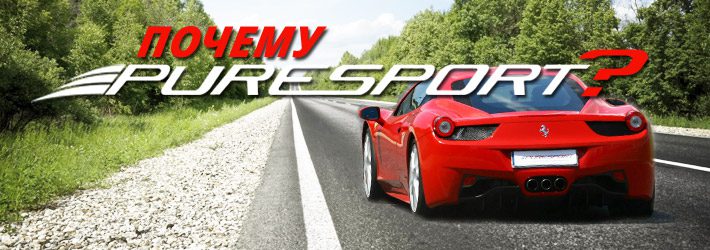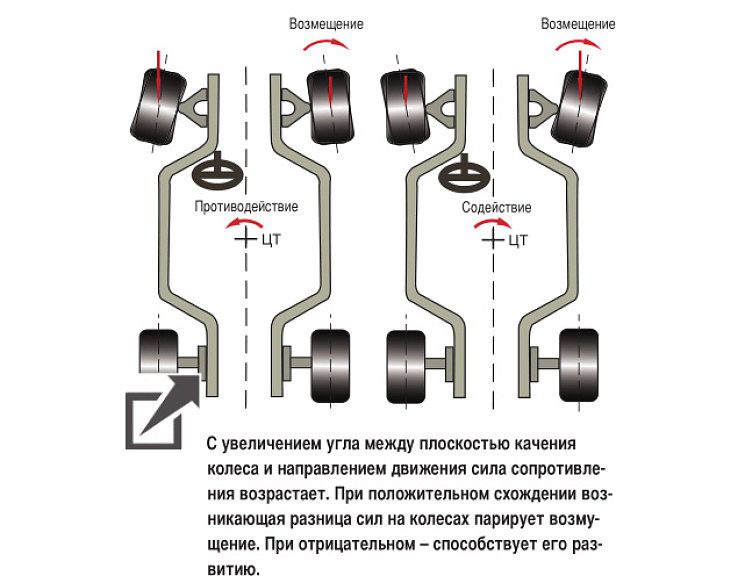
Driving and piloting
Techniques
Updates
Gyroscopic effect
It, as a rule, maintains an object in balance along its axis of rotation, which rotates by itself; the higher the speed, the greater the effect. It opposes the steering, and turning just by moving its center of gravity is not enough once the speed is high. It is this effect that allows the bike to remain balanced while riding.
The higher the rotation speed of the wheel, the greater the effect; hence the need for counter-controlled control above 40 km / h.
Centrifugal force
She pushes the bike out of the corner. Centrifugal force varies with the mass of the motorcycle (M), the square of the speed (V) and is inversely proportional to the radius of the curve (R). The rider compensates for this force with his weight and tilts the bike in a turn.
Formula: Fc = MV2 / R.
Uncontrollable
Also called reverse steering. It is a matter of putting pressure on the side of the steering wheel where you want to turn (so to turn right, you push on the right side of the steering wheel). This pressure creates an imbalance in the bike on the side you want to turn.
Mass transfer
During braking, the motorcycle dives forward. There is front-to-road ground transmission and tire grip is maximized. The rear wheel then tends to unload (or even take off altogether). As a result, the rear wheel is smaller and the risk of locking the rear wheel by too much rear brake is maximized.
City driving
Keyword: EXPECT
In the city (and elsewhere), we must start with the basic principle: the motorcycle is invisible. Therefore, it is good to see all the means: the low beam lights are of course on, but also the horn, the headlights ringing, the use of turn signals (warnings for those who have them) and for those who dare: a fluorescent jacket.
Then (or sooner, it depends) respect the safety distances. No, this is not reserved for highways. It's just a short distance between you and the vehicle in front of you in case it suddenly brakes.
Line of parked cars
Keep a constant eye on the wheels to see if it comes out (always without turn signals) and drivers should anticipate the door that will open.
Line of cars in motion
This is even more dangerous than the previous line. Watch out for vehicles that disconnect without warning. On a ring road, prefer the left lane (this is for your speed) and there is also less risk of a car on your left suddenly approaching you to allow another biker to pass.
Ogona on the right
The motorist NEVER looks in the right-hand mirror (he rarely looks in the rear-view mirror anymore). And since, in addition, according to the code, you are not allowed to overtake the right, it is recommended that you increase your caution.
Pedestrians
They rarely look ahead of the crossing, and besides, your motorcycle is smaller than the car, so they won't see you. Always keep two fingers on the brake lever. Beware especially of little old people who no longer hear very well and often cross (always?) Outside pedestrian crossings. The last time I saw such a meeting, it was an African twin and an 80-year-old little lady in an alley in the 16th arrondissement in Paris: a real massacre. I do not wish this on anyone.
priority
Intersections, roundabouts, stops, lights, parking exits. It exists for everyone but you. You never have priority! So be careful.
Curves in tunnels
This is always the spot chosen by oil stains and / or a broken truck. Anticipate the unimaginable.
Trucks
I have already spoken about motorists, but not yet about trucks. Their main danger comes from the fact that they hide everything. So avoid staying behind the truck. And throughout overtaking, expect the driver in front of the truck (so you don't see him) suddenly decide to change lanes. It's hot in the front. Get ready to prevent emergencies!
This danger is even clearer in the city when the truck / bus slows down / brakes in front of a pedestrian crossing. Experience shows that there is almost always a "hidden" pedestrian crossing, and the choice of this moment for the carriageway. Therefore, he arrives in front of the truck just when the biker makes a mistake, wanting to overtake (indeed, it is completely forbidden to bypass the pedestrian crossing, and there is a reason for this): therefore, vigilance, caution and slowing down are necessary to avoid the cardboard with the pedestrian, which appears at the last moment.
Rain
All of the aforementioned dangers are amplified, especially since the motorist sees even less and even less control over his car.
Then pay attention to anything that slips even more in the rain: sewer plates, white stripes, cobblestones.
Conclusion
Be paranoid! and keep the 10 commandments of the perfect thug
(The chain is less dangerous, needless to say).
Wheeling
Wheeling: A technique that lies between city driving and practice. In short, a technique for initiation to be used in moderation. This in order to spare the mechanics and avoid falling, came quickly.
There are two ways to make a wheel, but always in 1st or 2nd, depending on the car; either when accelerating or when clutching. It's always interesting before accelerating, decelerating, so the amortos settle down a bit and then open up as soon as they're back in place.
It is easier to dose at the beginning by putting yourself in second rather than first. It is also easier with a machine with torque and / or high displacement. Therefore, it is easier to raise 1000 than 125.
It is important to know the speed at which the bike is accelerating quickly. Correct diet is just pen testing without trying to get up.
The foot must then maintain contact with the brake pedal. It is the dosage of the rear brake that will allow the bike to return to both wheels in case of loss of balance. A wheel that turns into the sun is much less enjoyable than a good slide 🙁
Piano! word (oh) master! You must learn to tame the bike, its reactions, and your own reactions to fear. So, try it gently and in small pieces. Do not start in the city center, but rather on a small, straight road, well transparent (no traffic) and no disturbances. Ideally, have someone who knows how to do this with it. In any case, especially if the place is deserted, don't do it alone; in the event of a fall, it is better that there is still someone to call. But if you become soft and take your time, everything will be fine.
Acceleration:
- turn the handle quickly until the fork is unloaded,
- pull the steering wheel while holding acceleration,
- dose with a handle to maintain balance,
- slow down gently to allow the motorcycle to slowly return to both wheels (otherwise the fork suffers and the seals and bearings of the spinnaker will not withstand the brutal return to the ground for long)
Clutch:
The main thing is to wax the clutch to the desired RPM and then release the clutch. Easy 😉
Practical scheme
Brake
The distribution of brake use should generally be 70-80% for the front brake and 20% -30% for the rear brake. This rule varies greatly depending on location and pilot. Indeed, many drivers use little or no rear brake when racing. In fact, its use also depends on whether you are in a straight line or at the entrance to a turn.
In a straight line, using the rear brake carries the risk of dribbling.
Before a turn, the rear brake can be used two times: at the start of braking - at the same time as disengaging the throttle - to slow down the motorcycle (then use the front brake), then at the entrance to the turn, braking from the rear allows rear support to be restored (while the motorcycle has more front support) ) and
To shorten braking distances, it is especially helpful to take landmarks (see JoeBarTeam albums).
To brake, two fingers on the lever are sufficient and allow you to keep the rest of your fingers on the throttle grip so you can accelerate faster after braking (Note: Do arm and finger strength exercises).
Attention! Blocking the back rarely leads to a fall, on the other hand blocking the front, and this is a guaranteed fall.
Note: you always brake in a straight line (never cornering).
If you know you’re going straight, it’s better to bow and counter-counter in full (less risky, but easier said than done, I admit).
Downgrade
The downgrade function is only to be in right gear at the entrance to the bend (it is not used for deceleration at all). Then braking, decoupling and throttle must be coordinated.
Turning (milestone)
On the highway, as opposed to driving on the road, the entire width of the runway is used. This brings the curve closer to the right, placing itself as far to the left as possible.
- In a straight line: braking, lowering, look at the rope,
- Turning: counter-guided, transition to rope stitch,
- Exit the bend: straighten bike, accelerate.
When exiting a bend, you should be close to the edge of the path; otherwise, it means that on the next lap you can extend your trajectory to that boundary and thus get out faster.
Examples of correct trajectories
These are just a few examples. To turn the stud, you have to forget about the ideal trajectory in favor of strong braking and straightening the bike as quickly as possible.
In the case of turn sequences, it is often necessary to make a choice and give preference to one or another move. There is one twist in favor: the last one, the one that precedes the straight line. Indeed, the faster you get out of a bend in front of a straight line, the more you get a few km / h, which will lead to precious seconds of time.
Support
We use foot rests to control the bike! They serve as a support for moving around the bike, as well as for turning it. After re-accelerating, they allow the rear wheel to be lightened and thus shifted (read Champion Techniques below). The inner footrest is used to pivot the bike in a turn, while the outer footrest allows the bike to straighten faster during angle changes.
Chain preparation
If you decide to hit the track, here are a few points to adapt your bike to the track:
- Harden the suspensions (rear and front) to limit changes to the motorcycle
- Reduce the pressure in the tires slightly (for example 2,1 kg / cm2 instead of the usual 2,5 kg / cm2) so that they can heat up faster and improve grip.
Do not forget to resume road settings when exiting the road.
The last word
The main thing is to always be in support. The bike is in support and maximum grip during the acceleration and deceleration phases. Therefore, we must shorten the unsupported phases that cause the falls (I repeat).
Champion Techniques
Thigh and essentials. First, it allows the bike to swing at an angle with more force and speed while playing with the supports, especially on the footrests. Second, moving the body inside the corner removes the angle from the motorcycle. That is, at the same speed, you can make the same turn with a smaller angle, so there is more safety; or at an equal angle of the bike, you can go through a bend at a faster speed. Thirdly, knee placement allows for a corner marker.
Adrian Morillas (world endurance champion,
Yamaha Official Racer GP500)
The trick is to unload the rear of the bike to skate on the wheel. As a result, the bike slides and is faster in the right direction; it can be lifted faster.
Eddie Lawson (4 times 500 world champions)
If you have too much traction in the back, the front end will drift. When you go up from behind, if you open, you increase the slip, if you cut cleanly, the tire suddenly hangs and you are thrown out. You need to know how to practice pipetting to maintain consistent slippage.
Randy Mamola (runner-up 3 times 500)
The pilot divides the chain into four parts: the braking zone, the neutral cornering zone, the accelerating cornering zone and the straight line. The American driver thinks that if he saves time in the cornering zone, he will also benefit from it in a straight line. He sacrifices a little speed in the first areas to position himself by dragging the car into a position that is best able to take maximum acceleration out of the trajectory.

